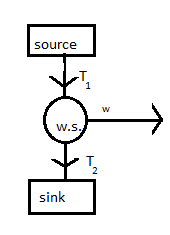
The efficiency of the heat engine
(A) Is independent of temperature of the source and the sink.
(B) Is independent of working substance.
(C) Can be $ 100\% $
(D) Is not affected by thermal capacity of the source and sink.
Answer
433.5k+ views
Hint: To solve this problem we should know about the heat engine working and their characteristics.
Heat engine: It is a system that converts heat or thermal energy into a mechanical energy. Which will be used to do mechanical work.
Efficiency: The fraction of work done by engine to heat given to the engine is called its efficiency.
Complete step by step solution:

As from the figure we can see that the working substance takes heat from the source and rejects heat to sink. So, in ideal conditions we assume that source and sink have infinite thermal capacity. Heat rejected by the source is equal to its temperature and heat going to the sink will be equal to temperature of sink.
So, efficiency will be, $ \eta = \dfrac{{work\,output}}{{heat\,input}} $
$ \Rightarrow \eta = \dfrac{{{T_1} - {T_2}}}{{{T_1}}} = 1 - \dfrac{{{T_1}}}{{{T_2}}} $
So, we can conclude that
Efficiency is dependent on source and sink temperature.
From formula we can say efficiency is independent of working substance.
From the formula, we can say its efficiency will never be $ 100\% $ because $ \dfrac{{{T_1}}}{{{T_2}}} $ is always a positive number.
The amount of heat taken from source and heat going to decapitate on the sink depend on its thermal capacity.
Hence, from the above observation, we can say option (b) is the correct option.
Note:
Heat engines distinguish themselves from other types of engine by the fact that their efficiency is limited by Carnot’s theorem. This efficiency limitation can be a drawback. Advantage of a heat engine is that most forms of energy can be easily converted to heat by processes like exothermic reaction, nuclear fission and absorption of light. Since heat sources that supply heat to the engine can be supplied energy by virtue of any kind of energy.
Heat engine: It is a system that converts heat or thermal energy into a mechanical energy. Which will be used to do mechanical work.
Efficiency: The fraction of work done by engine to heat given to the engine is called its efficiency.
Complete step by step solution:

As from the figure we can see that the working substance takes heat from the source and rejects heat to sink. So, in ideal conditions we assume that source and sink have infinite thermal capacity. Heat rejected by the source is equal to its temperature and heat going to the sink will be equal to temperature of sink.
So, efficiency will be, $ \eta = \dfrac{{work\,output}}{{heat\,input}} $
$ \Rightarrow \eta = \dfrac{{{T_1} - {T_2}}}{{{T_1}}} = 1 - \dfrac{{{T_1}}}{{{T_2}}} $
So, we can conclude that
Efficiency is dependent on source and sink temperature.
From formula we can say efficiency is independent of working substance.
From the formula, we can say its efficiency will never be $ 100\% $ because $ \dfrac{{{T_1}}}{{{T_2}}} $ is always a positive number.
The amount of heat taken from source and heat going to decapitate on the sink depend on its thermal capacity.
Hence, from the above observation, we can say option (b) is the correct option.
Note:
Heat engines distinguish themselves from other types of engine by the fact that their efficiency is limited by Carnot’s theorem. This efficiency limitation can be a drawback. Advantage of a heat engine is that most forms of energy can be easily converted to heat by processes like exothermic reaction, nuclear fission and absorption of light. Since heat sources that supply heat to the engine can be supplied energy by virtue of any kind of energy.
Recently Updated Pages
Master Class 11 Economics: Engaging Questions & Answers for Success

Master Class 11 Business Studies: Engaging Questions & Answers for Success

Master Class 11 Accountancy: Engaging Questions & Answers for Success

The correct geometry and hybridization for XeF4 are class 11 chemistry CBSE

Water softening by Clarks process uses ACalcium bicarbonate class 11 chemistry CBSE

With reference to graphite and diamond which of the class 11 chemistry CBSE

Trending doubts
What are the elders in Goa nostalgic about class 11 social science CBSE

Formaldehyde at room temperature is ALiquid BGas CSolid class 11 chemistry CBSE

Define least count of vernier callipers How do you class 11 physics CBSE

Distinguish between Mitosis and Meiosis class 11 biology CBSE

Why are forests affected by wars class 11 social science CBSE

Explain zero factorial class 11 maths CBSE




